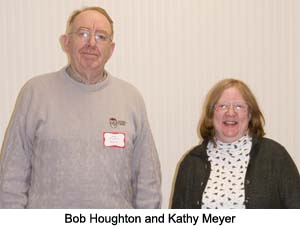Recovery Council February materials here: REE Discussed

In February, the two Blueprint tasks on the agenda were: 1) continuing work on NLCMH’s official organizational definition of recovery, and 2) examining the Recovery Enhancing Environment (REE) instrument which will be used in Blueprint Dimension 2, on Evaluation.
The Council also approved its January minutes, introduced Bob Houghton, who is replacing Brian Cook due to his moving out of the area, and introduced Kathy Meyer who was absent (with notice) the first meeting.
In the Blueprint Task portion of the meeting, CEO Greg Paffhouse described the big picture of what we are trying to build with regard to evaluation (Blueprint Dimension 2).
He explained that we want to measure recovery at Northern Lakes CMH – both the individual’s recovery journey, and the job Northern Lakes is doing as an organization to support recovery. The cornerstone measurement tool we’ll use is called the Recovery Enhancing Environment (REE) instrument. This is a self-report survey that gathers information and data about mental health recovery from people who receive mental health services. The Michigan Department of Community Health will be asking all 46 CMHs in the state to use the REE beginning in the summer.
Many consumers across the state studied a variety of other survey instruments and liked this one the best. It is hopeful and builds on people’s strengths and some of the other measures considered focused on the person’s challenges.
Greg explained that the REE asks people where they are in their process of mental health recovery, and what markers of recovery they are currently experiencing.
With the REE, people rate the importance of several elements (such as hope, sense of meaning, and wellness) to their personal recovery, and rate the performance of their mental health service on three activities associated with each of these elements. They also rate the service on factors in the system that promote resilience.
Open-ended questions encourage people to share the wisdom they have gained on their recovery journey, and to say how they think staff and systems could be more supportive of their recovery.
The vision in this area is to have a personal and system-level ongoing process that is simple, reliable, and consumer-driven, describing both formal and informal evaluation of an individual’s progress toward quality of life and including their current hopes and dreams.
What we want to build is a system where:
- Primary consumer outcomes identified for each service are measurable and observable (e.g., number of crises, percentage of people employed)
- Consumer and family measures of satisfaction are included in system evaluation.
- Recovery is evaluated both for the system and the individual; evaluation is aligned with MDCH recovery and satisfaction measurement(s) and CARF accreditation requirements; and in addition promotes local evaluation.
- High quality data is generated which yields information that is reliable, accurate, valid, complete and drives decision-making.
- Personal accounts and recovery successes/challenges are included in the assessment of an individual’s progress toward quality of life.
- Hope is evaluated (i.e., Hope Scales).
